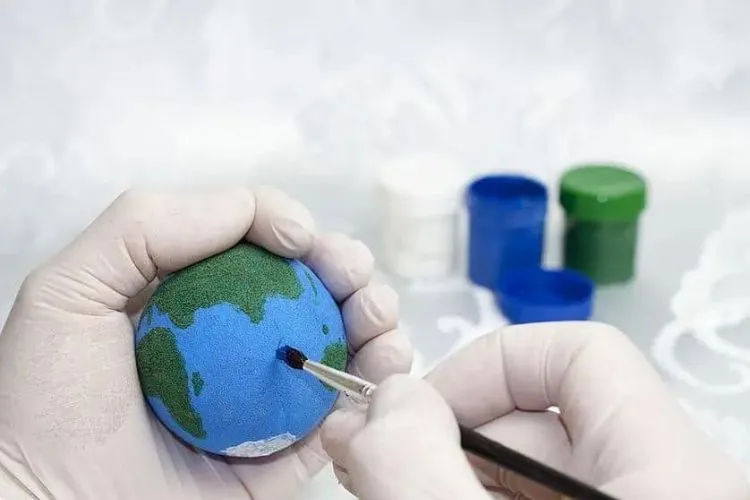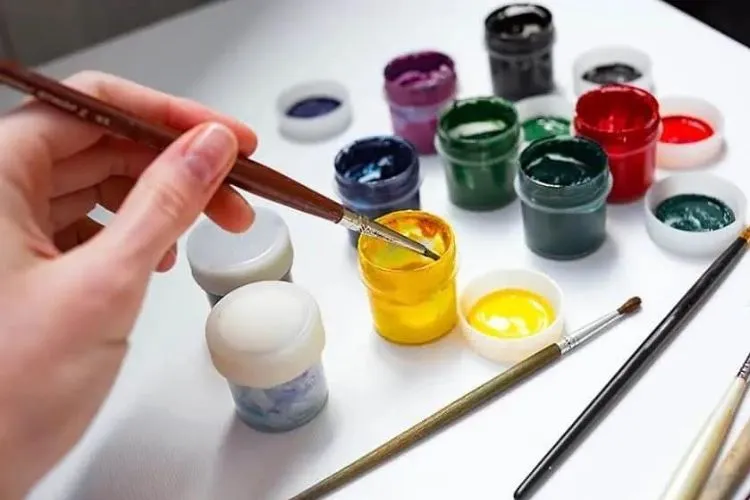Styrofoam, known for its lightweight and insulation properties, has become a staple in various crafts and DIY projects. From creating models and decorations to using it in art pieces, Styrofoam offers a versatile base. So, Can you use acrylic paint on styrofoam?
However, when it comes to adding color to this material, many question the suitability of acrylic paints. This guide delves into whether you can use acrylic paint on Styrofoam and how to achieve the best results if you decide to do so.

Understanding Styrofoam
Styrofoam is a form of polystyrene, known for its light weight and air-filled structure. Its applications in art and crafts are vast, thanks to its ease of shaping and cutting.
However, this very nature poses a challenge when applying paints or finishes, as not all materials react well with its chemical makeup.
Acrylic Paint and Its Compatibility with Styrofoam
Acrylic paint, a favorite among artists, is celebrated for its quick drying time and versatility. Being water-based, it raises concerns about its compatibility with Styrofoam.
When it comes to painting on Styrofoam, the key issue is not the water content but rather the chemicals within the paint that might react with the polystyrene.
Can You Use Acrylic Paint on Styrofoam?
The short answer is yes, you can use acrylic paint on Styrofoam, but with certain precautions. While direct application is possible, it’s essential to understand the chemical interaction between the paint and Styrofoam.
Acrylic paint can be safely applied to Styrofoam without causing damage, provided the surface is prepared properly.
Preparing Styrofoam for Acrylic Paint
To ensure longevity and adhesion of the paint, preparing the Styrofoam surface is crucial. This involves cleaning the surface to remove dust and debris.
For a smoother finish or if the Styrofoam surface is particularly rough, light sanding can help—even though this is a rare requirement.

Applying a primer, such as gesso, can create an ideal surface for the acrylic paint to adhere to, offering both protection to the Styrofoam and vibrancy to the colors.
Best Practices for Applying Acrylic Paint on Styrofoam
To apply acrylic paint on Styrofoam, selecting the right tools and methods is key. Using a soft, flat brush can minimize the appearance of brush strokes and avoid damaging the Styrofoam surface.
Apply the paint in thin, even coats to prevent the paint from peeling or flaking once dry. Waiting for each layer to dry completely before applying the next ensures the longevity of the paint job.
Alternative Methods and Materials
While acrylic paint is suitable, other materials can also be used for painting on Styrofoam. Water-based latex paint, for example, offers a thicker consistency and might provide better coverage without the need for multiple coats.
However, the choice of paint can depend on the specific needs of the project and the desired finish.
Common Problems and Solutions
Paint peeling, cracking, or uneven coats can occur when painting Styrofoam. To avoid these issues, using a primer and applying paint in thin coats are effective strategies.
If problems do arise, gentle sanding of the affected area followed by a reapplication of paint can often fix the issue.
Safety Measures While Painting Styrofoam
When painting Styrofoam, it’s crucial to prioritize safety to ensure a hazard-free crafting experience. First and foremost, work in a well-ventilated area to avoid inhaling fumes from acrylic paints and any sealers or primers used during the process. An open window or an exhaust fan can aid in maintaining good air circulation.

Protective gear is essential; wear gloves to shield your skin from paint and chemicals, and consider a mask or respirator if you’re using spray paints or engaging in extensive sanding. Safety glasses will protect your eyes from splashes or airborne particles.
To maintain cleanliness and safety, cover your working surface with newspapers or a disposable cloth to catch spills and drips. Once you’ve finished painting, clean up thoroughly. Wash brushes and tools with soap and water, and dispose of any used materials properly.
Seal paint containers tightly to prevent spills and store them in a safe place, away from children and pets. By keeping these safety measures in mind, you can enjoy crafting with Styrofoam and acrylic paint while minimizing risks.
You may also read: How to Prime Wood for Acrylic Painting?
Professional Tips for Advanced Techniques
Artists and professionals adept in working with Styrofoam and acrylics often leverage advanced techniques to bring their creations to life. Layering thin glazes of acrylics can build up color intensity and depth, while adding texture paste or modeling compound before painting introduces tactile elements.
Techniques like sponging and stippling create natural, organic patterns, perfect for replicating surfaces like stone or foliage. Dry brushing accentuates raised details with lighter shades, enhancing dimensionality.
Incorporating acrylic mediums directly into the paint or as a finish can modify the sheen, texture, and durability of the piece, allowing for customized effects tailored to the project’s specific needs.
Frequently Asked Questions (FAQs)
How long does acrylic paint take to dry on Styrofoam?
Drying times can vary based on paint thickness and environmental conditions, but typically, acrylic paint dries to the touch within hours on Styrofoam. Allow 24 hours for complete drying.
Can I use spray acrylic paint on Styrofoam?
Yes, but it’s essential to choose spray paints specifically designed to be safe for Styrofoam, as some solvents in spray paints can dissolve the material.
Is it necessary to use a primer before applying acrylic paint on Styrofoam?
While not strictly necessary, using a primer can significantly improve the adhesion and appearance of the paint.
Can acrylic painted Styrofoam be left outdoors?
Acrylic paint on Styrofoam can last outdoors temporarily if sealed properly, but long-term exposure to the elements is not recommended.
Are there any health concerns when using acrylic paint on Styrofoam?
It’s always wise to work in a well-ventilated area and use non-toxic paints, especially for projects involving children.
Conclusion:
Using acrylic paint on Styrofoam is a feasible and effective way to add color to your Styrofoam projects. Preparation, application technique, and choosing the right paint are all crucial steps to achieving a beautiful, lasting result.
By following the guidelines outlined in this guide, you can expand your craft and DIY project possibilities with confidence. Experiment, be creative, and remember to share your successes and lessons learned with the community.

Meet Isabella Anderson, your acrylic painting mentor with over a decade of brush-wielding mastery. Dive into the colorful world of acrylics with her expert guidance, featured exclusively on ‘Acrylic Authority.’ Unleash your inner artist and explore the limitless possibilities of this versatile medium alongside a true acrylic aficionado.
